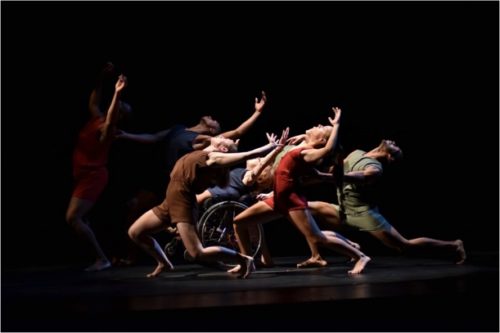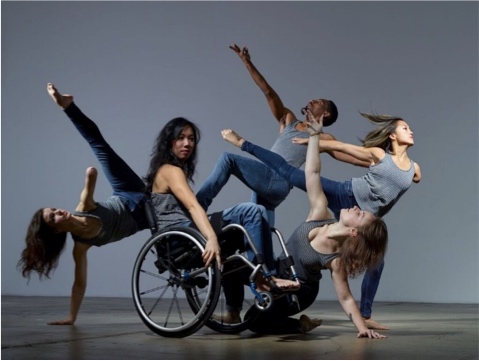
When the words “disabled” and “dancers” appear in the same sentence, many people think of special interest groups, therapy, or education, but the performances selected by Dance/NYC’s “Dance. Disability. Artistry.” (DDA) initiative are emphatically none of those things. They are integrated dancing, wherein dancers with and without disabilities share the stage and use their bodies to create works in which “artistic excellence and engagement is paramount,” according to Dance/NYC Director Lane Harwell.
Harwell and his staff began the project by trying to look at the data on disabled dance, only to find that it didn’t really exist. They decided to create it themselves, convening a DDA study and having a conversation around how to advance disabled artists. Through a disability-led panel including dancers, activists, executives, and a psychologist, DDA found that integrated dance was crucial to generating visibility for disabled dancers.
Visibility for performers with disabilities is decidedly lacking in the dance world. Traditional dance styles were created for able bodies and are often designed to showcase a classical body and athletic virtuosity; Western audiences in particular expect to see tall, thin, flexible, fit bodies on a stage. As Ann Cooper Albright, chair of the dance department at Oberlin College, has said, “As a woman in a wheelchair, I am expected neither to be a dancer nor to position myself in front of an audience’s gaze.” Disabled performers are nearly invisible in a genre so thoroughly devoted to physical perfection; if the only art you’ve ever seen has come from able-bodied dancers, it’s hard to imagine that disabled performers can create their own unique art.

Dance/NYC is changing this situation, flipping from thinking of disabled dancers as patients to thinking of their disabilities as a fount for creativity. Celebrated teacher and performer Kitty Lunn of Infinity Dance Theater transposes dance styles from standing to sitting, using her arms like legs and her hands like feet. “We are doing the same thing, differently,” she says of herself and her students.
Sign up for our free newsletters
Subscribe to NPQ's newsletters to have our top stories delivered directly to your inbox.
By signing up, you agree to our privacy policy and terms of use, and to receive messages from NPQ and our partners.
When Dance/NYC announced its Disability. Dance. Artistry. (DDA) Fund, designed to provide support for production costs of six performances that showcase dance-making by and with disabled artists, they expected fifteen or so applications but received nearly twice that many. “We were blown away by the demand,” said Harwell; “[it] signals a need and opportunity” for more integrated dance groups. Inclusive art scenes abound, especially in the nonprofit world, but they are often segregated as “special interest,” especially in performance.
Simply seeing disabled bodies on stage takes advantage of the connective power of art. Studies show that personal connection is one of the most effective tools for normalizing engagement with marginalized communities like people with disabilities. Art is a powerful connector, a shared experience of human emotion and curiosity that reaches each viewer individually. Albright warned that “when a disabled dancer takes the stage, he or she is staking claim to a radical space,” but DDA’s grantees are inclined to view the space as expansive rather than radical. Other dance companies, like Alvin Ailey American Dance Theater, Alpha Omega Dance, and Anna Myer and Dancers similarly engage audiences in nontraditional dance forms to give audiences a way to engage with unfamiliar traditions and communities.
The fund is supported by the Ford Foundation. The first set of grantees includes:
- AXIS Dance Company’s “AXIS at Gibney Dance”
- Jess Curtis/Gravity’s “The Way You Look (at Me) Tonight”
- Dancing Wheels Company and School’s “Physically Integrated Dance: Past Present and Future”
- Full Radius Dance’s “Do You Know What You Are Doing Now?”
- Kinetic Light’s (sponsored by Fractured Atlas) “Descent from Beauty”
- Heidi Latsky Dance’s “ON DISPLAY TIMESTAMPed”
One of Dance/NYC’s grantees, Full Radius Dance, grew out of an able-bodied dance company called Dance Force in 1998. Director Douglas Scott created an inclusive modern technique for his company, which ArtsATL has called “a sensitive, inventive and deeply thoughtful program, given by one of the Atlanta dance community’s most valuable assets.”
By including disabled dancers with able-bodied dancers, helping audiences see them through a “lens that privileges artistry,” Harwell hopes to create further opportunities for dialogue, engagement, and capacity building. Dance/NYC is hopeful that the concentration of activity will engage the dance community and provide a model for further programming. Nonprofits serving this community can benefit from the enhanced visibility of an underrepresented group of people, and the opportunity to highlight the potential waiting to be released.













